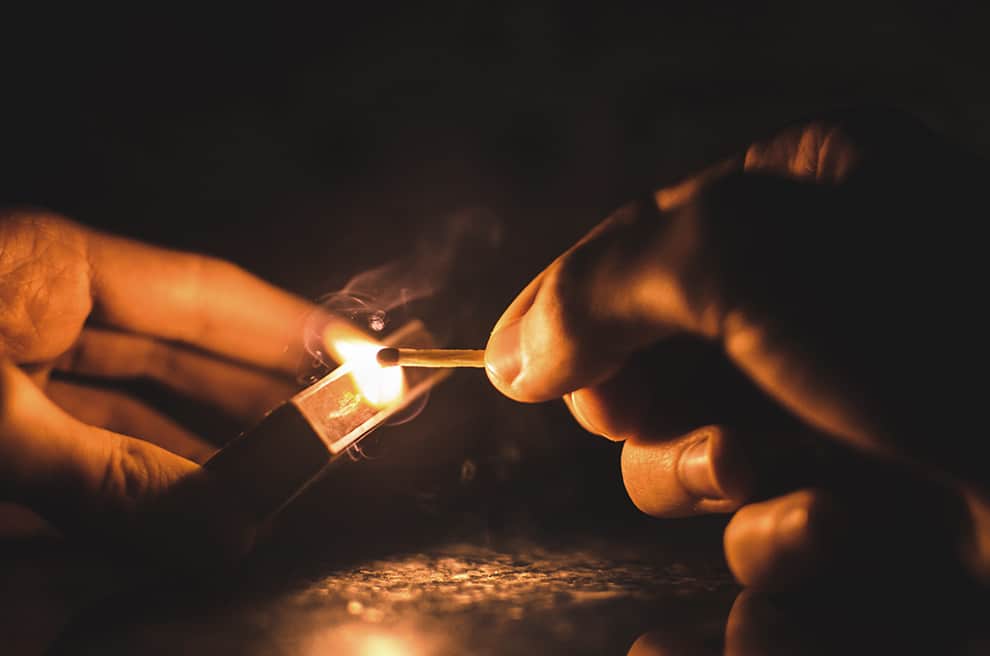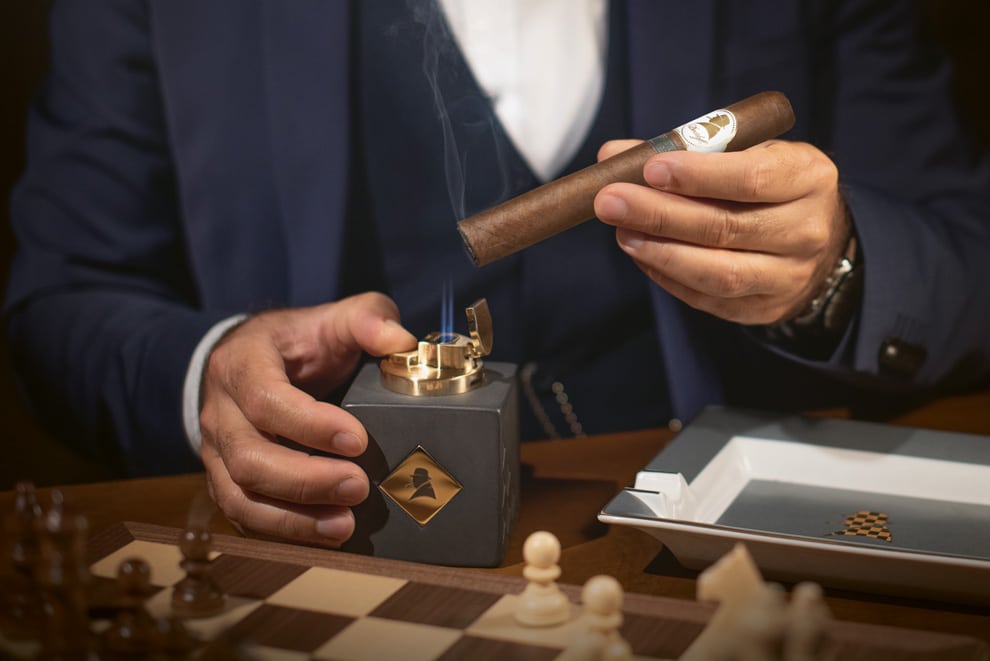When one is passionately committed to the world of Cigars, one is likely to overlook certain essential aspects in order to fully respect the art of lighting a cigar. The premium cigar is a precious product whose meticulous production requires a great deal of time. In many cases, this marvel takes years to manufacture. An estimated fifty pairs of hands are involved, from the planting of the seed to the final shipment to your local specialist. For an expert, nothing is more disconcerting than to observe a smoker inserting the foot of his cigar directly into the flame of a 1500-degree blue torch lighter. Indeed, the extreme heat will immediately carbonize the tobacco, resulting in a harsh, hot smoke, instantly attenuating its flavor potential. To light a cigar correctly, you need: a little patience, a little practice and, above all, time. All true amateur should aspire to respect the ritual of lighting. We've put together a list of seven steps to help you fully enjoy the aromas of your precious Cigars.
The 7 essential steps
- The Cigar must never touch the Flame
- Hold the cigar at a 45° angle to the flame, far enough away to allow the flame to "caress" the cigar without touching the foot.
- Rotate the cigar so that the foot lights up all around.
- Blow on the foot of the cigar to determine progress - the cigar will be lit when the entire foot sparkles with reddish-black areas, a sign to continue toasting.
- Gently exhale through the cigar to remove any potential impurities from the ignition source - this is commonly referred to as "purging".
- Start puffing naturally, rotating the cigar from time to time to regulate the burn and avoid any holes.
- Sit back and take time to enjoy the whole Cigar experience
Although a torch flame lighter can be used to properly light a cigar in the manner described above, some aficionados will prefer the traditional voice and use only a low-temperature yellow flame (match flame). The key is to choose the method best suited to the context. Indeed, when you decide to enjoy a cigar on a terrace, if the wind is blowing, it will be difficult to light with a soft flame. Numerous options are available and can be classified into four broad categories: flame lighters, matches, disposable butane lighters and refillable butane lighters.
Traditional lighting using cedar wood chips
And yes, you've guessed it, to do this, we use a scrap or strip of wood that we ignite at one end and use to deliver its flame to our Cigar. For centuries, this was how candles, lamps, ovens, stoves, cigars and smoking pipes were lit. In the old days, these little scraps were kept in a container above the fireplace, for easy access and immediate lighting. Traditionally, coal or wood was lit in a chimney fire using a firing pin. This tool resembled a pair of scissors, with one blade made of flint and the other of steel.
The determined amateur who uses this technique to light his puros will find his happiness in the many cigar boxes that contain a thin sheet of Spanish cedar inside - a type of mahogany that burns with a minimum of impurities. This leaf can be cut into narrow strips with a cutter, producing a handful of offcuts. In addition, some top-quality cigars - such as the Chateau Fuente Pyramids by Arturo Fuente - which are wrapped in cedar sleeves, can be unwound and then sliced.
The ideology behind using cedar off-cuts in the lighting process is to preserve the natural essence of the cigar. Indeed, these little jewels mature optimally when contained in a box made of Spanish cedar. The wood's aromas, over time, penetrate the cigar's flavors, so it would make sense to light the tobacco from the same material. However, this method is somewhat restrictive, as it requires the use of another ignition source.
Matches
In 1805, Jean Chancel invented the self-igniting match. Its head was made from a mixture of sulfur, potassium chlorate, sugar and rubber. It was ignited by dipping the tip into an asbestos bottle filled with sulfuric acid. Chancel's matches were expensive and inherently dangerous, which prevented their widespread acceptance. Over the following decades, various individuals improved on this marvellous invention. However, it wasn't until 1844 that the tool became widely used. Sweden's Gustaf Erik Pasch invented the "safety match", which separates the reactive ingredients between the match head and a striking surface impregnated with red phosphorus. Initially, these matches were made with one end in potassium chlorate and the other in red phosphorus, which required breaking the match in half and then rubbing one end against the other. In the late 1890s, American Joshua Pusey patented the matchbox, which he then sold to the Diamond Match Company.
A match produces a large, soft flame, with the added advantage of being found in most bars, convenience stores, gas stations, grocery stores, restaurants and tobacconists everywhere. The best choice would be a wooden match, as the residual chemicals of a paper match can alter the cigar's initial taste. In addition, the match head must be allowed to burn down completely before the flame is brought to the foot of the cigar. When lighting a vitola with a large ring gauge, two matches held tightly together can be used to create a large double flame. While many companies produce long matches specially designed for the cigar smoker, Davidoff offers sturdy 7 cm matches made from non-aromatic wood for clean, tidy burning.
Disposable butane lighters
Contrary to popular belief, the famous Bic was not the first disposable butane lighter on the market. That honor belongs to S.T. Dupont of Paris, who introduced the inexpensive Cricket lighter in 1972. It was only a year later that Bic began marketing its disposable butane lighter, which could deliver three thousand flames before the tank emptied. A Bic lighter produces a nice soft flame and works very well for toasting and lighting cigars with a ring gauge of 50 or less. The main disadvantage of using a Bic lighter is that the flame is not adjustable and diminishes in size as the fuel runs out.
Butane refillable lighters
The advantage of this type of gadget is that it can be lit in any situation, even on a terrace in strong winds. The options within this category are virtually endless, ranging from inexpensive units to precious lighters that could be classed as jewel-high. A standard Zippo lighter is not recommended, as it uses gas instead of butane.
The Xikar Forte delivers a wind-resistant yellow flame that can be used at altitudes of up to 12,000 feet, without going out. In addition to a large flame adjustment wheel at its base, the Forte features an integrated seven-millimeter cigar punch. This lighter was named Cigar Accessory of the Year 2016 by Cigar Journal. The brand Colibri offers a whole range of possibilities at various prices. The lighter Colibri Apex Silver Metallic is a well-designed, soft dual-flame lighter. Once lit, the apex produces two flames, one at a 45-degree angle and the other at a 90-degree angle. The two merge to create a bold flame that's big enough to easily light large-ring cigars.
Prestige brands Davidoff and S.T.Dupont produce top-of-the-range refillable butane lighters. Davidoff Prestige lighters vary in price range. They are offered in a number of opulent finishes - silver, gold, palladium and Chinese lacquer. Manufactured by S.T. Dupont and using Dupont Yellow Can butane, Prestige lighters by Davidoff are cut from a solid brass block and feature a dual-burner system, producing a soft, double flame ideal for lighting a cigar. The brand's latest jewel is the Winston Churchill special edition.
S.T. Dupont produces the widest range of options under its brand. Prices range from the Slim (170 chf) to the Prestige - in solid 18-carat gold. The brand's most popular model is certainly Line 2 (and more, depending on the finish).
The last word
Some believe that a true connoisseur will only light his puros with a gentle flame. After all, what really counts in the act of lighting is respecting the effort that goes into producing this exceptional product. So it's imperative to dedicate the necessary time to its proper appreciation. Of course, the hectic pace of life in which we strive to live doesn't always allow the right moments for these traditional lighting methods. On a windy afternoon, a gentle flame will prove difficult to tame, making the exercise almost unbearable. Cigars and their production are part of a long-standing tradition and know-how. That's why there's an appropriate label for your precious vitolas.
Source: cigardojo
































